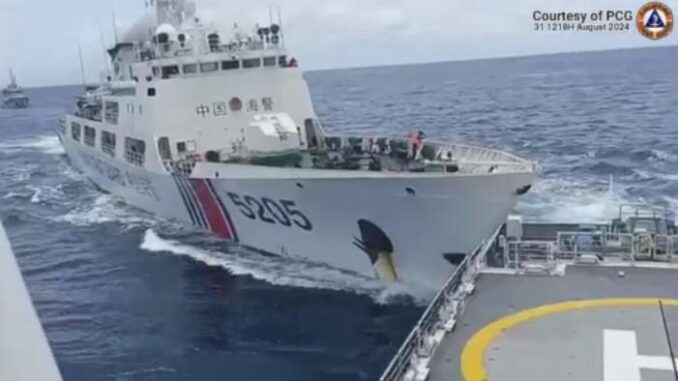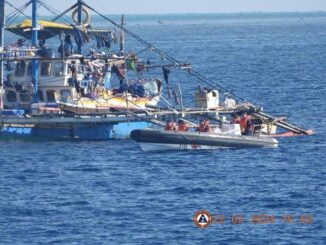
A Chinese Coast Guard (CCG) vessel on Saturday afternoon “intentionally” and repeatedly rammed the BRP Teresa Magbanua, which had been anchored on Escoda Shoal since April, according to the Philippine Coast Guard (PCG).
The incident was reported by PCG spokesperson for West Philippine Sea Commodore Jay Tarriela during a press conference in Manila.
Tarriela said the 97-meter (320-foot) BRP Teresa Magbanua, the largest vessel of the PCG’s fleet, heavied up its anchor to loiter around Escoda Shoal, located just 75 nautical miles or about 139 km from the main Palawan island.
This action caught the attention of both the CCG and Chinese maritime militia vessels around the area, the PCG said.
“Since the Chinese maritime forces noticed the movement of the Philippines Coast Guard vessel, that’s the time that more China Coast Guard vessels arrived and more Chinese maritime militia vessels also supported all these maritime forces to surround our vessel,” Tarriela said.
Later on, the PCG official said CCG vessel 5205 approached BRP Teresa Magbanua and “carried out a dangerous maneuver resulting in its direct ramming on the port bow of the MRV 9701 (Teresa Magbanua).”
However, the said CCG vessel did not stop there, Tarriela said, as it “turn[ed] around and then reached the starboard corner of the PCG vessel… and also directly and intentionally rammed MRV 9701 a few minutes after it carried out a dangerous maneuver and rammed the port bow of Teresa Magbanua.”
“After this it went around and did another ramming to the PCG vessel,” Tarriela said.
The PCG official said that the ramming of the CCG vessel towards BRP Teresa Magbanua “happened despite our unprovoked action and presence in Escoda Shoal.”
“The PCG vessel did not provoke or did not do anything while we were loitering around Escoda Shoal but the Chinese Coast Guard carried out dangerous maneuvers despite being unprovoked,” he said.
There were no reported injured personnel of the BRP Teresa Magbanua, according to Tarriela. The PCG vessel, however, was damaged.
“We still don’t have the details of the damage that we incurred. It will still be evaluated… [We’ll] send a team to evaluate and ensure sea-worthiness of BRP Teresa Magbanua despite the damage incurred as a result of direct ramming of the Chinese Coast Guard,” Tarriela said.
China’s view
Meanwhile, Liu Dejun, a spokesperson for China’s coast guard, said in a statement a Philippine ship, “illegally stranded” at the shoal, had lifted anchor and “deliberately rammed” a Chinese vessel. He called on the Philippines to withdraw immediately or bear the consequences.
“The Chinese coast guard will take the measures required to resolutely thwart all acts of provocation, nuisance and infringement and resolutely safeguard the country’s territorial sovereignty and maritime rights and interests,” Liu said.
For its part, the Chinese Embassy in Manila asked, ”Why [has] PCG 9701 [stayed] there since April?”
”That’s is the root cause of everything now,” it said. ”The Philippines is trying to create another Renai Jiao (Ayungin Shoal) situation in Escoda Shoal.”
Tarriela said Manila would not withdraw its ship “despite the harassment, the bullying activities and escalatory action of the Chinese coast guard.”
During the same press conference, National Maritime Council (NMC) spokesperson Alexander Lopez said the Philippines is only exercising its “sovereignty, sovereign rights, and jurisdiction over the area,” citing the 1982 United Nations Convention on the Law of the Sea (UNCLOS) and the 2016 Permanent Court of Arbitration ruling.
“So the CCG vessels are the ones illegally [there]… their presence there is illegal. We are there on a legal basis, atin ‘yun (it is ours),” Lopez said.
In a separate statement, the NMC said the Philippines ”condemns this unprovoked aggression and remains steadfast in upholding its sovereignty, sovereign rights and jurisdiction in the West Philippine Sea.”
“The Philippines will continue our routine maritime activities, protect our territory and maritime zones, and defend against environmental degradation and other illegal activities,” it added.
“As directed by the President, the Philippines will fully utilize and continue to pursue diplomatic channels and mechanisms under the rules-based international order and pursue the peaceful resolution of disputes.”
The U.S. ambassador to the Philippines expressed Washington’s support for the Philippines, a treaty ally.
“U.S. condemns the multiple dangerous violations of international law by the PRC (People’s Republic of China), including today’s intentional ramming,” Ambassador MaryKay Carlson said on social media platform X.
‘Legal, legitimate operation’
BRP Teresa Magbanua has been stationed in Escoda Shoal since April amid reports of China’s reclamation activities in the area.
Escoda Shoal is a coral reef formation with a central lagoon surrounded by discontinuous shallow sections. It is a rendezvous point for Philippine vessels headed to Ayungin Shoal, another contested feature in the West Philippine Sea, where the World War II-era vessel BRP Sierra Made has been aground since 1999.
Manila accused Beijing of building an artificial island, saying it had documented piles of dead and crushed coral on the sandbars, which Beijing denies.
Tarriela said the BRP Teresa Magbanua has been an issue for the Chinese government since it was stationed on the reef last April as Beijing claims it to be “semi-grounded” and would be a possible “deployment base.”
“But, as I said, the reason and objective of the deployment of BRP Teresa Magbanua is purely to carry out a legal and legitimate Coast Guard operation within our own exclusive economic zone,” the PCG official said.
Not the first time
The development comes after two separate incidents involving China Coast Guard (CCG) and Philippine ships in the area.
Last Sunday, CCG vessels rammed and used a water cannon on the Bureau of Fisheries and Aquatic Resources (BFAR) ship near the shoal. GMA Integrated News reporter Ian Cruz was onboard the BFAR vessel when the incident occurred.
The BRP Datu Sanday, which was rammed five times, was on a humanitarian mission from Hasa-Hasa Shoal to deliver diesel, food, and medical supplies to Filipino fishermen in Escoda Shoal.
The next day, August 19, CCG vessels blocked two Philippine Coast Guard ships on a rotation and reprovisioning (RORE) mission to the BRP Teresa Magbanua.
In a statement, the CCG said it took “control measures… in accordance with law and regulations” against the BRP Datu Sanday, which “illegally stormed” into China’s territory.
The NMC on Wednesday said the Philippine government has sent a statement to China expressing serious concern over the August 19 incident. China Coast Guard spokesperson Gan Yu earlier claimed on social media platform Weibo that Philippine vessels BRP Bagacay and BRP Cape Engaño “deliberately” collided with a CCG vessel near Escoda Shoal.
Beijing claims almost the entire South China Sea, a conduit for more than $3 trillion in annual ship commerce. Its territorial claims overlap with those of the Philippines, Vietnam, Malaysia, and Brunei.
Manila refers to parts of the waters within its exclusive economic zone as the West Philippine Sea.
In 2016, an international arbitration tribunal in the Hague ruled that China’s claims over the South China Sea had no legal basis, a decision Beijing does not recognize. — with a report from Reuters and Jamil Santos/VDV/VBL, GMA Integrated News





Be the first to comment